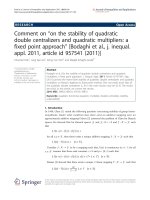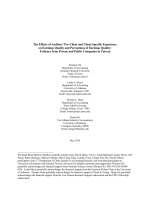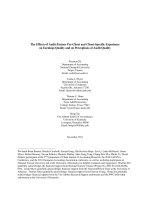Chesini et al (eds ) the business of banking; models, risk and regulation (2017)
Bạn đang xem bản rút gọn của tài liệu. Xem và tải ngay bản đầy đủ của tài liệu tại đây (2.29 MB, 169 trang )
Palgrave Macmillan Studies in Banking and
Financial Institutions
Series Editor
Philip Molyneux
University of Sharjah, Sharjah, UAE
The Palgrave Macmillan Studies in Banking and Financial Institutions series is international in
orientation and includes studies of banking systems in particular countries or regions as well as
contemporary themes such as Islamic Banking, Financial Exclusion, Mergers and Acquisitions, Risk
Management, and IT in Banking. The books focus on research and practice and include up to date and
innovative studies that cover issues which impact banking systems globally.
More information about this series at http://www.springer.com/series/14678
Editors
Giusy Chesini, Elisa Giaretta and Andrea Paltrinieri
The Business of Banking
Models, Risk and Regulation
Editors
Giusy Chesini
Department of Economics, University of Verona, Verona, Italy
Elisa Giaretta
Department of Business Administration, University of Verona, Verona, Italy
Andrea Paltrinieri
Department of Economic and Statistical Sciences, University of Udine, Udine, Italy
Palgrave Macmillan Studies in Banking and Financial Institutions
ISBN 978-3-319-54893-7 e-ISBN 978-3-319-54894-4
/>Library of Congress Control Number: 2017943467
© The Editor(s) (if applicable) and The Author(s) 2017
This work is subject to copyright. All rights are solely and exclusively licensed by the Publisher,
whether the whole or part of the material is concerned, specifically the rights of translation,
reprinting, reuse of illustrations, recitation, broadcasting, reproduction on microfilms or in any other
physical way, and transmission or information storage and retrieval, electronic adaptation, computer
software, or by similar or dissimilar methodology now known or hereafter developed.
The use of general descriptive names, registered names, trademarks, service marks, etc. in this
publication does not imply, even in the absence of a specific statement, that such names are exempt
from the relevant protective laws and regulations and therefore free for general use.
The publisher, the authors and the editors are safe to assume that the advice and information in this
book are believed to be true and accurate at the date of publication. Neither the publisher nor the
authors or the editors give a warranty, express or implied, with respect to the material contained
herein or for any errors or omissions that may have been made. The publisher remains neutral with
regard to jurisdictional claims in published maps and institutional affiliations.
Cover image: © Maciej Bledowski/Alamy Stock Photo
Cover design: Tom Howey
Printed on acid-free paper
This Palgrave Macmillan imprint is published by Springer Nature
The registered company is Springer International Publishing AG
The registered company address is: Gewerbestrasse 11, 6330 Cham, Switzerland
Acknowledgements
First and foremost, we would like to thank all our contributors, whose biographies are provided in
this volume, without which the edited book would not have been possible.
Also, we want to express our gratitude to all participants of the 2016 Wolpertinger Conference—
organized by the European Association of University Teachers of Banking and Finance in September
2016 at the University of Verona—for their insightful comments about all the papers included in this
volume.
We would also like to show our gratitude to Professor Philip Molyneux (Professor of Banking
and Finance and Dean of the College of Business, Law, Education and Social Sciences), editor in
chief of the Palgrave Macmillan Studies in Banking and Financial Institution Series, for approving
our book proposal and for his support during the process.
Also, many thanks to the Palgrave Macmillan team, Aimee Dibbens and Natasha Denby, for their
support during the publishing process.
Special thanks to the institutions which kindly supported the Wolpertinger Conference in Verona
and so contributed to make it a pleasant and fruitful event: Banco Popolare, Unicredit (Verona), and
S&P Global Market Intelligence.
Finally, as conference organizers, we would like to thank Steven Ongena, Professor at the
University of Zurich, for giving a plenary speech at the conference on “Relationship Lending
Reloaded” and the other speakers at the Jack Revell Session on “The Financial System in the
Macroeconomy” (Cesare Bisoni, University of Modena; Maurizio Faroni, General Director at Banco
Popolare; Phil Molyneux, Bangor Business School; and Greg Udell, Indiana University).
Contents
1 Introduction
Giusy Chesini, Elisa Giaretta and Andrea Paltrinieri
2 Interest Rates and Net Interest Margins: The Impact of Monetary Policy
Paula Cruz-García, Juan Fernández de Guevara and Joaquín Maudos
3 The Swedish Mortgage Market: Bank Funding, Margins, and Risk Shifting
Viktor Elliot and Ted Lindblom
4 Incapability or Bad Luck? Testing the “Bad Management” Hypothesis in the Italian Banking
System
Fabrizio Crespi and Mauro Aliano
5 Why Do US Banks React Differently to Short Selling Bans?
Daniele Angelo Previati, Giuseppe Galloppo, Mauro Aliano and Viktoriia Paimanova
6 Reputational Risk in Banking: Important to Whom?
Ewa Miklaszewska and Krzysztof Kil
7 The Business Model of Banks: A Review of the Theoretical and Empirical Literature
Stefano Cosma, Riccardo Ferretti, Elisabetta Gualandri, Andrea Landi and Valeria Venturelli
8 On European Deposit Protection Scheme(s)
Milena Migliavacca
9 A Technical Approach to Deposit Guarantee Schemes
Francesca Arnaboldi
Index
List of Figures
Fig. 2.1 Intervention interest rates by the main Central Banks
Fig. 2.2 Three-month interbank rates evolution
Fig. 2.3 Net interest income evolution (% total assets)
Fig. 2.4 Economic impact of the net interest margin determinants (bp). The graph shows the effect on
net interest income of a variation of 25–75 percentile of the distribution in each of the explanatory
variables. The bars that have a more subdued colour correspond to variables whose effect is not
statistically significant. The variables are sorted from highest to lowest impact on net interest income.
The equation [2] of the Table 2.2 was used for the analysis
Fig. 2.5 Observed changes in interest rates and predicted changes in the net interest margin (bp)
Fig. 3.1 Illustration of overcapitalization of CB issues
Fig. 3.2 Growth (in mEuro) of outstanding CBs on the Swedish market since 2006
Fig. 3.3 Indirect issuing of CBs through a bank-owned “building society”
Fig. 3.4 Direct issuing of CBs through a bank-owned “building society”
Fig. 3.5 Illustration of the roles of actors involved in CB issues
Fig. 3.6 Average discounts on the banks’ officially offered mortgage rates the past year
Fig. 3.7 Aggregate bank funding 1996–2015
Fig. 3.8 Pre- and post-CB claims by different bank funds providers on bank assets in case of
bankruptcy
Fig. 3.9 Average market rates and risk premiums on 2- and 5-year covered bonds (CB/MB) relative
government bonds (GB) for 2000–2016
Fig. 3.10 Average official mortgage rates of the five Swedish “mortgage” banks from 2000 to 2016
Fig. 3.11 Deviations of the banks’ officially offered mortgage rates from 2000 to 2016
Fig. 3.12 Marginal mortgage lending margins of the average bank from 2000 to 2016
Fig. 3.13 Illustration of average interest rate margins if borrowing short and lending long
Fig. 7.1 BM definition: the different approaches in the management literature
Fig. 7.2 Strategic components of banking business model (BBM)
Fig. 8.1 EU28 Member States DPSs’ design
Fig. 9.1 Banks (%) and coefficients
List of Tables
Table 2.1 Descriptive statistics (2003–2014 averages)
Table 2.2 Determinants of net interest income: 2003–2014
Table 2.3 Observed changes in interest rate and yield slope curve and predicted changes in net
interest margin (bp)
Table 3.1 Credit ratings of CBs issued by Swedish institutions
Table 3.2 Key figures (in SEKm) of selected banks as of December 31, 2015
Table 4.1 Dataset description
Table 4.2 Mean ratio of impaired loans on credit to clients for the banks in our dataset
Table 4.3 Descriptive statistics of variables used
Table 4.4 Panel regression. Bank-specific determinants on credit quality
Table 4.5 VIF test results
Table 4.6 Redundant Fixed Effects Tests
Table 4.7 Panel regression. Bank-specific determinants on credit quality. GMM
Table 5.1 Fundamental variables description
Table 5.2 Short selling ban interventions in US financial sector
Table 5.3 Descriptive statistics
Table 5.4 Fundamental firms’ analysis
Table 5.5 Stock price change
Table 5.6 Total and systematic risk analysis
Table 6.1 Scoring scale used in the model
Table 6.2 Description of explanatory variables
Table 6.3 Panel data estimations for MLPS, CEE-11, 2009–2014
Table 6.4 Panel data estimations for ROE, CEE 2009–2014
Table 8.1 Deposit protection scheme (DPS) features
Table 8.2 Design features distribution across European countries
Table 8.3 Deposit protection schemes (DPSs) in the EU28
Table 8.4 Funding and management design
Table 9.1 Balance sheet ratio computed from Bankscope
Table 9.2 Thresholds, classes and coefficients
Table 9.3 Statutory position, aggregate indicator and scaled aggregate indicator
Table 9.4 Year-to-year statutory position
Table 9.5 Weighted average aggregate indicator
Table 9.6 Changes in statutory position after risk adjustment—all years
Table 9.7 Descriptive statistics—EBA core and additional indicators
Table 9.8 Buckets, boundaries and individual risk score
Table 9.9 Buckets, relative boundaries and individual risk score
Table 9.10 Aggregate risk weight
Table 9.11 Number of banks, risk classes, ARW core and ARW core+additional (2013 and 2014)
Table 9.12 Risk classes (FITD versus EBA)
Table 9.13 Changes in risk classes
Table A.1 Test for difference in means—ROE
Table A.2 Top and bottom quartile—ROE
Notes on Contributors
Mauro Aliano is an Assistant Professor of Banking and Finance at the University of Cagliari,
Faculty of Economics, Law and Political Sciences. He is a specialist in applying statistics techniques
for analyzing financial markets, in methods for analyzing financial instruments and in portfolio
models. In 2012, he was a research fellow at the University of Rome Tor Vergata.
Francesca Arnaboldi is Associate Professor of Banking and Finance at the University of Milan,
Italy. She holds an MSc in Financial Management from the University of London, CeFIMS, and a
Ph.D. in Finance from the University of Bologna. She has been a visiting scholar at Stern School of
Business, New York University. She is a member of the CEFIN (Centre for Research in Banking and
Finance), University of Modena and Reggio Emilia and of the Centre for Banking Research, Cass
Business School, City University. Her main areas of interest are international banking, bank
competition and performance, financial innovation, bank regulation, and supervision.
Giusy Chesini is Associate Professor in Banking and Finance at the University of Verona, Italy.
She holds a Ph.D. in financial markets and intermediaries from the University of Bergamo, Italy.
Giusy is also the author of several papers and books related to the evolution of financial
intermediation. Her research topics include financial markets, stock exchanges, banking and corporate
finance.
Stefano Cosma is Professor of Banking at the University di Modena and Reggio Emilia, Italy. He
holds a Ph.D. in Business Administration from University Cà Foscari, and a Master’s degree in
Organization and Management of Human Resources. He is a member of CEFIN (Centre for Research
in Banking and Finance).
Fabrizio Crespi is researcher of Banking and Finance at the University of Cagliari and Contract
professor at ALTIS—Post Graduate School Business and Society—at the Catholic University of
Milan. His main research fields are as follows: organizational models of credit institutions and other
financial intermediaries, internationalization and financial intermediaries, asset allocation, and
portfolios optimization.
Paula Cruz-García is a Ph.D. student in Economics and Quantitative Finance at the University of
Valencia. She graduated in Economics at the University of Valencia, and she holds a Master’s degree
in Quantitative Banking and Finance from the University of Valencia, Complutense University of
Madrid, University of Castilla La Mancha, and the University of the Basque Country. Her main
research interests are banking economics, financial economics, and econometrics.
Viktor Elliot is Assistant Professor in Banking, Finance and Accounting at the School of Business,
Economics & Law, University of Gothenburg. His interests include performance management, risk
and regulatory implications in banking, funds transfer pricing, and savings banks. Current research is
conducted within the areas of financial exclusion, supply chain finance, and regulatory implications in
banking.
Riccardo Ferretti is Professor of Banking and Finance at the University di Modena and Reggio
Emilia, Italy. He holds a Ph.D. in Financial Markets and Portfolio Management from University of
Bergamo. He has been a visiting Ph.D. student at Graduate School of Business Administration, New
York University. He is a member of CEFIN (Centre for Research in Banking and Finance).
Giuseppe Galloppo is Assistant Professor of Financial Markets and Institutions at Tuscia
University, Viterbo, and a research fellow at the School of Economics, Tor Vergata University of
Rome. He teaches banking and finance, with a particular focus on financial markets and institutions
and risk methods. He is a specialist in applying statistical techniques and methods for analyzing
financial instruments and portfolio models and for assessing risk profiles of securities and financial
assets portfolios.
Juan Fernández de Guevara is Assistant Professor of Economics at the University of Valencia,
where he graduated and obtained his Ph.D. (with special honors) in Economics. Since 2011, he is
associate researcher of the Ivie. His specialized fields are banking, productivity analysis, and social
capital. At present, he is a researcher in the SPINTAN Project of the European Union’s Seventh
Framework Programme and has been a consultant for the United Nations and the European Investment
Bank (EIB). He has published fifteen books and chapters and more than twenty articles in specialized
journals such as Journal of Banking and Finance, The Manchester School, The European Journal of
Finance, Journal of International Money and Finance, Revista de Economía Aplicada, Regional
Studies, Applied Economics Letters, among others, and has taken part in more than twenty-five
national and international congresses.
Elisa Giaretta is a Research Fellow at the University of Verona, Italy, where she received a Ph.D.
in Business Administration and Management. She works in the ‘Polo Scientifico e Didattico di Studi
sull’Impresa’, an academic centre focused on the analysis of Italian enterprises. Her research topics
include private equity, companies’ networks and bank risks.
Elisabetta Gualandri is Full Professor of Banking and Finance in the “Marco Biagi” Department
of Economics of the University of Modena and Reggio Emilia. She is a director of the European
Association of University Teachers in Banking and Finance. She served as an auditor of Banca
d’Italia from 2007 to 2012, when she was appointed to the Board of BPER banca. Her recent
research topics include regulation and supervision of financial intermediaries and markets, financial
crisis, the financing of innovative SMEs, and public intervention programs.
Krzysztof Kil is Assistant Professor of Banking and Finance at the Cracow University of
Economics, Faculty of Finance and Law, Poland. His research concentrates on the issues of bank
stability and bank efficiency in Central and Eastern Europe.
Andrea Landi is Full Professor of Banking and Finance in the “Marco Biagi” Department of
Economics of the University of Modena and Reggio Emilia, and the President of Fondazione Cassa di
Risparmio di Modena from 2005 to 2015. He served as an auditor of Cassa Depositi e Prestiti from
2014 to 2016. His recent research topics include bank strategies, efficiency and performance,
financial crisis, financing of innovative SMEs and public intervention programs, asset management.
Ted Lindblom is Professor of Business Administration at the University of Gothenburg, Sweden.
His current research interests mainly concern corporate finance and banking. In the corporate finance
area, he particularly focuses on corporate governance, capital budgeting, and financial structure
decisions. In the banking area, his emphasis is on banking strategies, pricing, profitability, and risk
management under different market condition and regulatory frameworks. He has authored and coauthored several articles and books regarding these issues.
Joaquín Maudos is Professor of Economics at the University of Valencia, Research Deputy
Director at the Ivie and collaborator at the CUNEF. He has been visiting researcher at the Florida
State University Finance Department, at the College of Business at Bangor University, and at the
School of Business of the University of Glasgow. He has also been a consultant to the European
Commission, the European Investment Bank, and the United Nations. He has jointly published
seventeen books and nearly ninety articles in specialized journals (European Journal of Finance,
Journal of Banking and Finance, Journal of Comparative Economics, Journal of Financial Services
Research, Journal of International Financial Markets, Institutions and Money, Journal of International
Money and Finance, Regional Studies, Review of Income and Wealth, Journal of Business Economics
and Management, etc.). He is a member of the Editorial Board of the journal Inversión & Finanzas, as
well as director of competitive projects.
Milena Migliavacca is a Ph.D. candidate and Contract Professor of Financial Intermediaries at
Catholic University in Milan and visiting Ph.D. student at Essex Business School, University of
Essex. Her current research interests concern financial literacy, social impact investment, and deposit
insurance schemes design.
Ewa Miklaszewska is a Professor in Banking and Finance at the Cracow University of Economics
(CUE), Poland, where she chairs the Banking Division. She is an Associate Professor of Economics
at the Jagiellonian University in Cracow, Department of Management and Public Communication. She
has held several visiting positions at both foreign universities and Polish financial regulatory
institutions. Her research interests focus on bank regulation and bank strategies.
Andrea Paltrinieri is Assistant Professor in Banking and Finance at the University of Udine, Italy.
He holds a Ph.D. in Business Administration from the University of Verona, Italy. Research topics
include asset management and institutional investors, with a particular focus on sovereign wealth
funds, Islamic finance and the relative financial instruments such as sukuk, commodity markets and
exchange traded products.
Viktoriia Paimanova is a researcher of Financial Markets and Institutions, School of Economics
and Management, at V.N.Karazin Kharkiv National University (Ukraine). She focuses her interests on
statistics and analyzing of financial markets, assessment of risk profiles and financial assets. In 2014–
2016, she was a research fellow at Tuscia University (Italy).
Daniele Angelo Previati is Full Professor of Financial Markets and Institutions in the Department
of Management of the University of Rome III and Professor at the SDA Business School, Bocconi
University, Milan. He has been teaching banking and finance for more than 30 years, with particular
focus on bank management, strategy, and organization in the financial services industry and e-finance.
His main research interests relate to various perspectives on bank management: human resources
management, intellectual capital, organizational change, stakeholder management, and finance for
SMEs. He has published widely in academic journals and books. He has also acted as a consultant
for banks and the Italian Central Bank on organization design and human resources management.
Valeria Venturelli is Associate Professor in Banking and Finance at the “Marco Biagi”
Department of Economics of the University of Modena and Reggio Emilia, where she teaches
Financial Markets and Institutions at both undergraduate level and graduate level. She graduated in
Economics from the University of Modena and Reggio Emilia and received a Ph.D. in Financial
Markets and Institutions from the Catholic University of Milan. Her main research interests are the
economics of banking and other financial institutions and valuation methods. She is the author of
several articles in leading academic journals. She has acted as a consultant to various public
institutions and consulting firms. She is a member of CEFIN—Center for Studies in Banking and
Finance and Softech-ICT.
© The Author(s) 2017
Giusy Chesini, Elisa Giaretta and Andrea Paltrinieri (eds.), The Business of Banking, Palgrave Macmillan Studies in Banking and
Financial Institutions, />
1. Introduction
Giusy Chesini1 , Elisa Giaretta1 and Andrea Paltrinieri2
(1) Department of Business Administration, University of Verona, Verona, Italy
(2) Department of Economic and Statistical Sciences, University of Udine, Udine, Italy
Giusy Chesini (Corresponding author)
Email:
Elisa Giaretta
Email:
Andrea Paltrinieri
Email:
This text comprises a selection of papers that offers new insights into banking business models, risks
and regulation proposals in the aftermath of European financial crises. It investigates the main issues
affecting the business of banking nowadays such as low interest rates and non-performing loans. The
combined effect of low to negative interest rates and weak economic growth has encouraged banks to
shift their business towards new areas, less related to interest rates, that financial markets and
institutional investors are evaluating. Contributions also offer new insights into topics not yet fully
investigated by the literature such as banks’ short-selling bans after Brexit, the European Deposit
Guarantee Scheme and banks’ risk appetite framework.
These chapters were originally presented as papers at the annual conference of the European
Association of University Teachers of Banking and Finance (otherwise known as the Wolpertinger
Conference) which was held at the University of Verona, Italy, at the beginning of September 2016.
In particular, the second chapter, “Interest Rates and Net Interest Margins: The Impact of
Monetary policy,” by Paula Cruz-García, Juan Fernández de Guevara, and Joaquín Maudos, examines
the determinants of bank’s net interest margin, focusing on the effect of interest rates, and thus
monetary policy decisions. The analysis is carried with a panel of banks from 32 OECD countries
over the period 2003–2014. The results show a quadratic relationship between net interest margins
and interest rates, implying that the variation of the latter (and therefore monetary policy) has a
greater effect when interest rates are low. An important implication of economic policy regarding the
results obtained is that there is a trade-off between economic growth and financial stability
associated with the impact of expansionary monetary policy when the level of interest rates is very
low. As a result, if the current scenario of low and even negative interest rates persists for much
longer in certain countries (such as in the Eurozone), it will have a negative effect on bank
profitability and consequently on financial stability.
Chapter 3, “The Swedish Mortgage Market—Bank Funding, Margins and Risk Shifting”, by
Viktor Elliot and Ted Lindblom analyzes the Swedish mortgage market, especially focusing on bank
funding, margins, and risk shifting. It discusses the move from mortgage-backed bonds to covered
bonds regime in Sweden and its implications for bank’s profitability and risk-taking. This chapter
concludes by offering a discussion about the risk of a new financial crisis in Sweden.
In Chap. 4, “Incapability or Bad Luck? Testing the “Bad Management” Hypothesis in the Italian
Banking System” by Fabrizio Crespi and Mauro Aliano, by using specific evidences from the Italian
banking sector and following a microeconomic approach, the authors test the “bad management”
hypothesis first introduced by Berger and Deyoung (1997), which suggests that poor managerial
practice causes an increase in problem loans after a lag. This chapter gives a contribution to the
existing literature in this field; in that, it investigates nonperforming loans (NPLs) and other soured
loans jointly. Their results confirm the “bad management” hypothesis, in that they discover a positive
(lagged) relation between the value of past due/overdrawn loans and NPLs which, in a management
perspective, indicates the incapability of the credit manager to anticipate or to recover (at least
partially) problematic credits.
The fifth chapter, “Why Do US Banks React Differently to Short Selling Bans?” by Daniele
Angelo Previati, Giuseppe Galloppo, Mauro Aliano and Viktoriia Paimanova, is about short-selling
ban which caught high attention of policy modeling in different countries. This work is one of the first
to explain the evidence of different bank price reactions in terms of country and stock market
conditions, and to consider both stock price reaction and risk side. All in all, their findings suggest
that the impact of the ban on the overall market efficiency is heterogeneous and, in most cases, modest
for the countries analyzed. Indeed, you either do not observe any improvements or they are only shortlived. This chapter checks the short selling response of US banks, listed in the SP500 in 2008. For the
first time, we document that banks react to ban restrictions differently, mostly because of their variety
in terms of fundamental factors (balance sheet indicators). Considering that, US banks show different
reactions to the ban on short selling. Policy makers should decide which of firm characteristics are
better to choose and whether interventions are effective on the market.
Chapter 6, “Reputational Risk in Banking: Important to Whom?” by Ewa Miklaszewska and
Krzysztof Kil, aims to examine the relevance of reputational risk for banks and the incentives to
manage it. The efforts to manage reputational risk as a self-standing type of risk, and not within an
operational risk framework, are quite recent. Consequently, in the empirical part of this chapter, the
authors propose a methodology to measure reputational risk, based on the bank stakeholders’
perspective.
Chapter 7, “The Business Model of Banks: A Review of the Theoretical and Empirical
Literature” by Stefano Cosma, Riccardo Ferretti, Elisabetta Gualandri, Andrea Landi, and Valeria
Venturelli considers that the business model (BM) has become a key concept in banking literature.
The topic’s relevance is due to the impact of the crisis on bank profitability and risk levels, leading to
new challenges for bank managers, analysts, and regulators. This chapter deals first of all with the
definition of BM in the management literature; afterward the focus is on bank business model (BBM)
and the business model analysis (BMA) literature, also considering the nexus with bank
diversification. The point of view of supervisory authorities is critically analyzed with specific
regard to BMA embedded in the Supervisory Review and Evaluation Process (SREP).
Chapter 8, “On European Deposit Guarantee Schemes” by Milena Migliavacca, aims to provide a
dynamic overview of the Deposit Protection Schemes (DPSs) across the EU28. Using data gathered
by the World Bank’s Bank Regulation and Supervision Surveys, the analysis critically systematizes
the different features that shape the national DPSs’ design. Finally, this study highlights the area
where legislative intervention is most needed in order to reach a full-fledged European Deposit
Insurance Scheme (EDIS).
Finally, Chap. 9, “A Technical Approach to Deposit Guarantee Schemes” by Francesca
Arnaboldi, fits within the debate on deposit guarantee schemes in the European Union, currently under
revision, investigating the changes proposed by directive 2014/49/EU of the European Parliament and
the Council and regulated by the European Banking Authority. For Italian banks, new rules introduce
risk-based contributions to be paid ex ante to the national deposit guarantee scheme. The framework
proposed by the European Banking Authority results in a better classification for Italian banks, which
requires lower payments to the scheme. Concerns are raised about the effectiveness of the European
Banking Authority guidelines.
© The Author(s) 2017
Giusy Chesini, Elisa Giaretta and Andrea Paltrinieri (eds.), The Business of Banking, Palgrave Macmillan Studies in Banking and
Financial Institutions, />
2. Interest Rates and Net Interest Margins: The Impact
of Monetary Policy
Paula Cruz-García1 , Juan Fernández de Guevara1, 2 and
Joaquín Maudos1, 2
(1) University of Valencia, Valencia, Spain
(2) Instituto Valenciano de Investigaciones Económicas, Valencia, Spain
Paula Cruz-García (Corresponding author)
Email:
Juan Fernández de Guevara
Email:
Joaquín Maudos
Email:
2.1 Introduction
Several central banks have adopted an expansionary monetary policy in recent years so as to combat
the impact of the last financial crisis on the economy. In addition to the low monetary policy interest
rates (Fig. 2.1) resulting from the measures adopted (both conventional and unconventional), there is
also a fall in the long-run natural rate of interest 1 : This derives from an excess of savings in relation
to investment due to demographic factors (such as the ageing of the population and the depression in
consumption which this entails), a lower rate of technological progress (with the consequent secular
stagnation of economies), low prices of raw materials, particularly oil, and increased demand for
safe assets (pushing prices upward and decreasing yields), etc. What all of this leads to is a scenario
of very low (or even negative) interest rates. In fact, a high percentage of debt in many countries has
negative interest rates.
Fig. 2.1 Intervention interest rates by the main Central Banks. Source: Bank of Spain.
According to a recent analysis by the International Monetary Fund (2016), the expansionary
monetary policies adopted by some central banks have eased the access to finance (by reducing the
cost of funding and increasing the availability of credit), thus stimulating aggregate demand.
However, a prolonged period of reduced interest rates can impair bank intermediation margins (and
therefore profitability), given the existence of a floor in deposit interest rates, since it is difficult for
banks to pass on the drop in interest rates to the deposits interest rates, at least in the case of
households. 2 For this reason, the net interest margin is seen to be most affected in those banks with a
greater proportion of financing via deposits. Likewise, the greater the proportion of variable interest
rate loans in a bank, the greater the deterioration of its profitability, as a result of the fall in financial
revenues due to the reduction of the money market interest rates.
The European Central Bank (2016), on the other hand, highlights in its Annual Report that the
expansionary measures adopted have a positive impact. The positive impact is driven by the fact that
the drop in interest rates has led to an improvement in the quality of bank assets (since less risky
projects are financed), an increase in lending activity and a drop in non-performing loans as a result
of economic recovery.
Other papers, such as Rostagno et al. (2016), also provide empirical evidence of the increase in
credit growth due to the policy of negative rates, showing that loans to companies have increased in
the Eurozone with the current expansionary policy.
Taking the above mentioned into account, it is important to differentiate between the impact that
falling interest rates have had up until now and the impact of these extremely low, or even negative,
rates persisting for a prolonged period. To date, the effect has not been negative, as stated by the IMF
and the ECB. However, the IMF warns that if this scenario persists for much longer, it will have an
adverse effect on the net interest margin and therefore on bank profitability, primarily due to the floor
in interest rates on deposits, as well as a flattening of the yield curve which has taken place with the
falling interest rates.
In this context, the objective of this study is to analyse the impact of the variation of interest rates
on the net interest margin and the possible existence of a non-linear relationship which would explain
why the impact of monetary policy differs depending on the level of interest rates. Thus, if the
relationship is quadratic, a fall in interest rates could be harmful for bank margins if the level of rates
is low, while the same drop in rates can have beneficial effects with high rates (as a result of the
reactivation of the demand for credit, reducing non-performing loans, etc.).
Since there are very few works to date which have empirically analysed the effect of a prolonged
period of low-interest rates on banking net interest margins (and therefore on profitability), further
evidence is needed on this subject. But given the current context of such low rates, this issue has
attracted attention as shown by the recent works by Borio et al. (2015) and by Claessens et al.
(2016). Using samples of banks from various countries, both papers provide evidence demonstrating
the existence of a non-linear relationship between interest rates and the net interest margin. In
addition to these two works, are those by Genay and Podjasek (2014) which analyse the effects of
expansionary monetary policy on the bank margin in the USA, and Busch and Memmel (2015) for
German banks.
Our work provides further empirical evidence for a sample of 32 countries from around the world
for the period 2003–2014, a period that includes years of expansion in which accommodative
monetary policies were adopted and the subsequent years of crisis in which expansionary monetary
policy measures were implemented, both conventional (such as a decrease in intervention rates), as
well as unconventional (QE, negative rates which penalise excess bank reserves, etc.). The work is
focused on quantifying the impact of short-term interest rates on bank interest margins, testing the
hypothesis of whether the relationship between interest rates and the margin is indeed quadratic.
However, we also consider the impact of other variables as determinants of net interest margins,
which capture the characteristics of each bank (market power, credit risk, risk aversion, operating
costs, etc.), along with other control variables (market risk, etc.). We have taken variables used as
determinants in the model by Ho and Saunders (1981) and some of their additions together with the
reference framework by Borio et al. (2015).
The results obtained indicate that the impact of interest rates on the intermediation margin is
quadratic rather than linear. Accordingly, taking into account this concave relationship and the current
low rates, a normalisation in monetary policy would have a significant effect on margin recovery.
Similarly, this result also shows that if this situation persists for much longer (and even worse, if the
negative rates which penalise excess bank reserves in some countries are increased), it could have a
negative impact on financial stability as a result of the fall in bank profitability, which is already at an
extremely low level (and below the cost of raising capital) at least in European banking.
In addition to this introduction, our paper is structured as follows. Section 2.2 examines the
theoretical framework on the determinants of bank intermediation margins and presents the testable
hypothesis. Section 2.3 describes the sample used, defines the variables of the model and the
empirical approach, and explains the methodology used. Section 2.4 shows the results obtained and
Sect. 2.5 checks the robustness of the results. Finally, Sect. 2.6 presents the conclusions and the
economic policy implications.
2.2 Theoretical Framework and Testable Hypothesis
2.2.1 Theoretical Framework
There are various theoretical frameworks in which the behaviour of net interest margins is modelled
(see, for example, Zarruk 1989; or Wong 1997). However, most of the works in the literature take the
model developed by Ho and Saunders (1981 ) as a starting point. Allen (1988) extended this model
by incorporating different types of loans and deposits. In this extension, the author showed that the
margins can be reduced when one considers the cross elasticity of demand between banking products.
Angbazo (1997), on the other hand, expanded the original model by taking into account credit risk as
well as interest rate risk. Maudos and Fernández de Guevara (2004) extended the model to include
operating costs. In addition, their analysis of net interest margins in the main sectors of European
banking uses a direct measure of the degree of market power, such as the Lerner index. Carbó and
Rodríguez (2007) included non-interest income as a determinant of the margin.
In all these models, the bank is considered as an (risk averse) intermediary, maximising the
expected utility of its wealth EU ( ), between suppliers and demanders of loans in a static
framework over a single period. In the model, the banks set interest rates (r L and r D ) on their loans
(L) and deposits (D), setting markups a and b on the money market interest rate (r). Banking activity
is subject to two types of risks: (1) the uncertain profitability of their loans associated with default
risk; and (2) the risk that banks take because of their position in the money market to which they call
on when they need to grant new loans or to place excess liquidity. Both risks are introduced by
assuming that interest rates on loans and the money market have a probability function with variance
y , respectively. In addition, both risks are related (with covariance σ LC ). For each additional
loan or deposit, banks must assume operating costs Exp(Q L ) or Exp(Q D ), respectively. Finally, the
loans and deposits reach banks according to Poisson processes which depend on the spreads that
banks set on the interbank interest rate. These processes include the parameters that determine the
market power (α/β) of banks in their markets.
In an application for the case of German banking, Entrop et al. (2015) include the cost of the
maturity transformation, defining the equation that describes the determinants of the intermediation
margin (s) in the following way:
With these additions to the original model by Ho and Saunders (1981), the determinants of the net
interest margin are the level of interest rates (r, r L and r D ), the degree of competition (α/β), risk
(credit risk, as well as market risk, and their interaction- ,
and
-), bank risk aversion,
, the overheads, the volume of the initial credit portfolio L 0 and of deposits D 0, and
the average size of operations Q L and Q D .
Other group of papers (see Gerali et al. 2010) use a dynamic stochastic general equilibrium
model with an imperfect competition. These authors postulate a linear relationship between bank
margin and the level of interest rates. Alesandri and Nelson (2015) consider a simple version of
former model in partial equilibrium with the same conclusion.
More recently, Borio et al. (2015) used the Monti-Klein model for the case where oligopolistic
competition exists between N banks, incorporating the cost of maturity transformation, the capital
requirements coefficient and an equation for provisions for possible loans losses. The determinants of
the net interest margin included in the empirical application are the three-month interbank interest
rate, the slope of the yield curve and the interest rate risk, in addition to macroeconomic indicators
and variables that approximate the characteristics of each bank (bank size, risk aversion, liquidity and
efficiency). This paper focuses on the influence of monetary policy on the intermediation margin both
through the impact of the short-term interest rates and the slope of the yield curve. These authors find
that the level of interest rates, which is the key variable in our work, has a positive non-linear
relationship with the net interest margin, depending on the curvature of the value of elasticity of
demand for loans and deposits and on capital requirements.
In the same vein, Claessens et al. (2016) provide empirical evidence on the negative effect of the
drop in interest rates on net interest margin, with the impact being greater when interest rates started
at a low level, obtaining a quadratic relationship between the money market interest rates and the net
interest margin.
2.2.2 Testable Hypothesis
In this context, our work takes into account all previous contributions in so far as we analyse the
determinants of the net interest margin by including the various explanatory variables put forward, but
with emphasis on the effect of interest rates and hence the impact of monetary policy.
Our testable hypothesis is the following: controlling for bank characteristics and macroeconomic
variables, an increase in interest rates has a positive effect on net interest margin, the impact being
greater when interest rates are low. In other words, we expect a positive and concave relationship
between net interest income and the level of interest rates.
2.3 Data, Definition of Variables and Methodology
2.3.1 Data
The data used for the empirical analysis come from the BankScope database (Bureau Van Dijk),
which contains information on the balance and the income statement of a representative sample of
banks from around the world. To control the influence of other macroeconomic variables which affect
the intermediation margin, the World Bank database is used, while the money market interest rates
come from the OECD database.
The sample used includes financial institutions (banks, savings banks, credit unions and other
types of banks) from 32 OECD 3 countries.
The period examined is from 2003 to 2014. Excluded from the sample are those banks that do not
provide the necessary data with which to calculate any of the variables required for econometric
specification and those whose input prices, necessary for estimating the Lerner index of market
power, are outside the range of the 2.5 standard deviations on either side of the mean calculated for
each year. With these filters, the panel of data finally used is made up of 54,540 observations.
2.3.2 Variables
In order to carry out the empirical contrast, we used variables put forward by Ho and Saunders
(1981) and their subsequent extensions, adding the level of interest rate and its square, as do Borio et
al. (2015). Therefore, the following variables are needed for econometric specification: the level of
short-term interest rates, market power, the degree of bank risk aversion, money market volatility
(interest rate risk), credit risk, the interaction between both types of risk, the volume of credit,
liquidity reserves and average production costs. Each of these variables is approximated as indicated
below:









